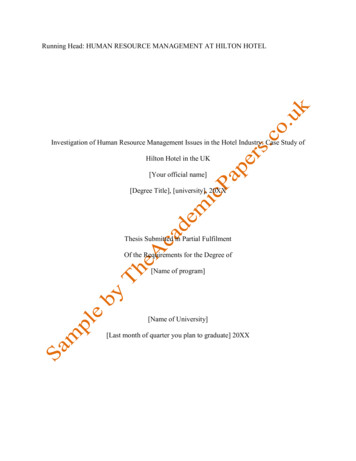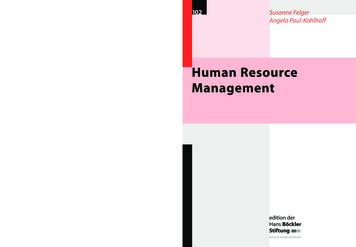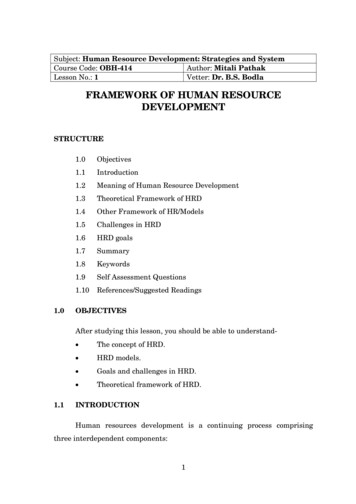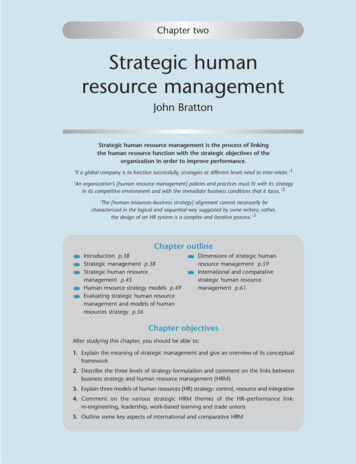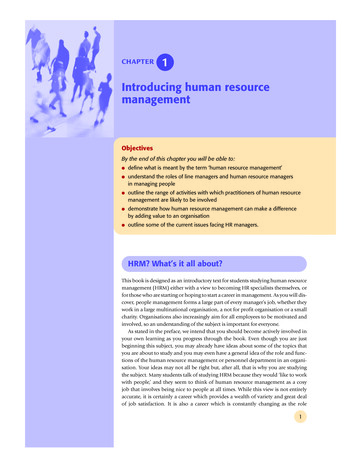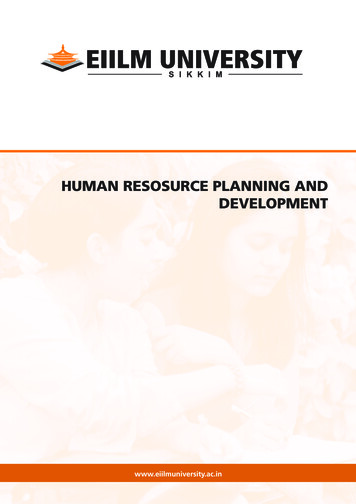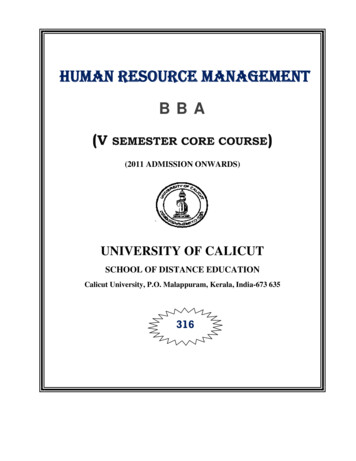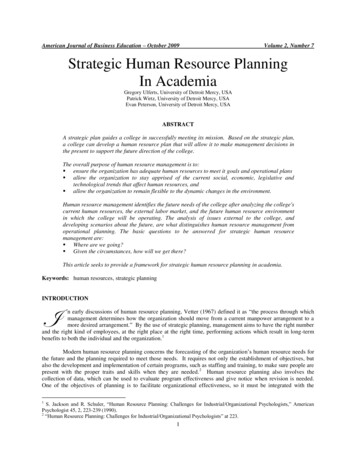
Transcription
International Journal of Research in Business Studies and ManagementVolume 5, Issue 3, 2018, PP 24-30ISSN 2394-5923 (Print) & ISSN 2394-5931 (Online)Human Resource Planning as an Important Practice toAnticipate Future Human Resource Requirements of theOrganization – Literature review.Dr. Janes O. Samwel, PhDEast Africa Regional Human Resource Manager, Ausdrill East Africa, Mwanza, Tanzania/Part timeSenior Lecturer-Mount Meru University,Tanzania*Corresponding Author: Janes O. Samwel, East Africa Regional Human Resource Manager, AusdrillEast Africa Mwanza, Tanzania/Part time Senior Lecturer-Mount Meru University, Tanzania.ABSTRACTHuman resource planning is one of the most important human resource practice in the organization.Organizations rely much on human resource planning to determine their current position and future needsof manpower. The purpose of this paper is to examine the importance of human resource planning to theorganization by reviewing different literature on human resource planning. This paper reviews the literaturerelating to human resource planning and it focuses on the objectives of human resource planning, theprocess of human resource planning and importance of human resource planning to the organization, Thefindings depicts that there is a significant relationship between human resource planning and organizationalmanpower requirements and between human resource planning and organizational performance, thereforethis paper recommends that organizations should continue to practice and maintain effective humanresource planning as it plays fundamental role in achieving the objectives of the organizations.Keywords: HR Planning, Practice, Future HR Requirements and Organization.INTRODUCTIONOrganizations are formed by people and thesame people are the most important strategicresource in the organization, there is noorganization that can achieve its objectiveswithout people. There must be a properutilization of human resource in organizations inorder to achieve high-performance standard(Lunenburg, 2012), and all the objectives of theorganization are achieved through effectivehuman resource planning, effective humanresourceplanning is a mechanism for buildinglong-term capacity to meet the workforcechallenges (Choudhury, 2007), therefore, humanresource management has the opportunity toenable organizations to survive, grow, becompetitive and profitable (Werner, Jackson &Schuler, 2012).Human resource planning plays an importantrole in human resource management because ittranslates the objectives of the organization intoa number of workers needed by determining thehuman resource required by the organization toachieve its strategic goals. In order for anorganization to manage its human resource, itmust ensure effective human resource planning.Human resource planning is a key to manpowerrequirements in the organization. Humanresource planning is one of the most importantelements in a successful human resourcemanagement program (De Cenzo & Robbins,1988). An organization that implements itshuman resource planning effectively is likely toprosper in a competitive environment, studiesshowed about 80 % of the middle sized andlarger companies now perform human resourceplanning on a regular basis (Craft, 1988). Theoptimal utilization of human resources is animportant success factor contributing to longterm competitiveness (Zülch, Rottinger &Vollstedt, 2004). Human resource planning isvital in organizational unstable periods likeduring mergers, amalgamation, consolidationand when labour market settings are studied orwhen joblessness is low (Mello, 2001).Human resource planning is a core humanresource management process that seeks toprepare organizations for their current andfuture workforce needs by ensuring the rightpeople are in the right place at the right time(Jacobson, 2010). Human resource planning canInternational Journal of Research in Business Studies and Management V5 I3 201824
Human Resource Planning as an Important Practice to Anticipate Future Human ResourceRequirements of the Organization – Literature review.be used to achieve organisational objectives byunderstanding and planning for people needs inthe short, medium and long-term (Colley &Price, 2010).LITERATURE REVIEWThe Concept of Human Resource PlanningIt is the work of the organization to determineits current and future manpower requirementsthat will help to meet its objectives. Accordingto Bulla and Scott (1994), human resourceplanning is a process for ensuring that thehuman resourcerequirementsoftheorganization are identified and plans are madefor satisfying those requirements. Milkovich andBoudreau (1993) outlined that human resourceplanning is the process of collecting and usinginformation on the base of which it can bediscussed as the number of resources spent onpersonnel activities. Mondy and Noe (2006)advocated that human resource planning is theentry point of human resource managementconcerned with the determination of humanresource requirements, job analysis, recruitment,selection and socialization. Reilly (2003)defined workforce planning as a process inwhich an organization attempts to estimate thedemand for labor and evaluate the size, natureand source of supply which will be required tomeet the demand. Anyim, Mba and Ekwoaba(2012) were of the opinion that Human resourceplanning is a first and most basic, activity of thehuman resource management function.Khadka (2009) stressed that human resourceplanning must be linked to the overall strategyof the organization. Koubek (2007) stated thatpersonnel planning serves to achieve the goalsof the organization by development prediction,setting the targets and realizing arrangementsleading to current and future ensure of businesstasks with adequate manpower.Dessler and Varkkey (2009) affirmed thatpersonnel planning embrace all future positionsand planning flows from the firm’s strategicplan. Mullins (2003) condemned that humanresource planning as the process of planning forthe work- force needs of an organization toensure that the personnel needs are constantlymet and this is achieved through demand andsupply analysis. Dwevedi (2012) saw humanresource planning as a process which helps outin properly performing important humanresource functions such as true and timelyinformation which is provided about when to do25recruitment of employees. Cascio (1992)narrated that human resource planning can bedefined as an effort to anticipate future businessand environmental demands on an organization,and to provide the employees to fulfil thatbusiness and satisfy those demands. Walker(2002) affirmed that human resource planning isthe process of identifying and responding to theissue of workers and charting new policies,systems and programs that will ensure effectivehuman resource management under changingconditions. Mursi (2003) postulated that humanresources planning is a process of guidingactivities related to the human resourcesmanagement. Human resource planning is aprocess that put one organization in suitableplace by having the correct number and desiredhuman resource that meets the purpose of theorganization (Jahanian, 2009). Forecastingmanpower demand involves the estimation ofthe number and type of human resource requiredat different levels in different departments in anorganization (Pradeesh, 2011). Randal (2000)was of the view that human resource planning isthe process that consists of developing andimplementing plans and programs to ensure thatthe right number and type of individuals areavailable at the right time and place to fulfilorganizational needs.Objectives of Human Resource PlanningReilly (1999) highlighted that there are severalreasons why organization chooses to engage inhuman resource planning. Michael (2006)contended that, the aims of human resourceplanning in any organization will largely dependon its context. The purpose of human resourceplanning is to forecast organisational needs foremployees taking into account the internal andexternal supply of labour to meet staffingrequirements; that is, identifying the gapbetween what is needed and what is available(Santos, Zhang, Gonzalez & Byde, 2009). Noe(2012) highlighted that other factors thatinfluence forecasting demand for personnelinclude budget constraint, turnover due toresignations, contract terminations, transfers andrelocations, retirement, new technology in thefield, decisions to upgrade the quality ofservices provided and minority hiring goals.That when it comes to the human resourceplanning context, a mathematical formula isused to project future demands of humanresources based on an established relationshipbetween an organization’s employment leveland some measurable factors of output such asInternational Journal of Research in Business Studies and Management V5 I3 2018
Human Resource Planning as an Important Practice to Anticipate Future Human ResourceRequirements of the Organization – Literature review.revenue, sales or production level. Walker(1980) established that human resource planningoccupies an important role to forecast futuredemands of business and environmental factorsin the organization and it also helps to generateand manage the human resource demands asrequired and as conditions depict. Imison,Buchan and Xavier (2009) contended thatgetting the balance right between labour demandand supply is the most common objective ofhuman resource planning.Ulrich (1987) advocated that human resourceplanning is recognized as a source of developmentof organizational functions based on missionsand objectives of the business. Like mostorganizational practices, the effectiveness ofhuman resource planning depends on theperspective within which it is utilized (Walker,1990).Process of Human Resource PlanningHuman resource planning captures all actionsinvolving continuous environmental scanningand reviewing of organizational strategies,objectives, and policies in order to ensure thatthe right quality and quantity of humanresources are available when and where they areneeded.(Randhawa, 2007). Dessler, (2001) opined thathuman resource planning is an ongoing processthat is not static involving many interrelatedactivities which must be modified and updatedas conditions require.Randall (2000) asserted that human resourceplanning involves making an inventory ofcurrent human resources in order to determinethe human resource status, for example, thecurrent size and kind of the human resources aswell as work scope, the inventory involvesexamining the available employees skills andnumber of employees, the experience and agestructure span of control.Harbison (1973) argued that, human resourceplanning consists of various activities whichinclude forecasting human resource requirements,making an inventory of present human resourcesand assessing the extent to which these resourcesare employed optimally, anticipating humanresource problems by projecting present resourcesinto the future and comparing them with theforecasts of requirements to determine theiradequacy and planning the necessary programsof requirements, selection, training anddevelopment, utilization, transfer promotion,motivation, and compensation to ensure thatfuture human resource requirements that areproperly met.Relatively, John (2008) advocated that five stepsprocess is used for creating a linkage betweenhuman resource or workforce planning anddepartmental planning to regulate the currentand future requirements and demands of thehuman resource include determination of businessgoals, environmental scanning, performing gapanalysis, deciding human resource priorities andmeasure, monitor and report the progress.Edwards (1983) discussed three pillars ofmanpower planning which are the prediction ofthe future demand in human resource, theprediction of the future supply of the humanresource and closing the gap between the firstand second pillar and making policies for that.Izueke (2009) pointed that human resourceplanning requires detailed analysis of thepresent and the future to ensure that theorganization has the right number of peopleavailable who possess the right kinds of skills toperform the jobs required by the organizationwhen the work is needed. Butter, (2002) advisedthat it is important to note that the quality ofhuman resource planning depends on personalrecords. Ghazala & Habib, 2012) contended thatthe process of human resource planning shouldensure that, an organization’s employees havethe requisite skills and competencies anenterprise needs for it to succeed.Importance of Human Resource Planning tothe Organization.Armstrong (1992) postulated that theimportance of increasing productivity is one ofthe most critical goals in business and Humanresource planning is essential for the achievementand attainment of this productivity. Parker andCaine (1996) mentioned that it is important fororganizations to have the right number ofmanpower in order to avoid the unwantedsituation such as the issue of shortage andexcess of manpower. Cole (2002) said thathuman resource planning is critical to thesuccess of an Organization’s strategy and planningis tied to the nature of organizations. Reilly(2003) concurred that human resource planningpractices enable a firm to estimate the demandfor labour and evaluate the size, nature, andsources of supply which will essentially berequired to meet the demand. Craft (1980)observed that human resource planning influencesthe calibre and type of applicants who choose toInternational Journal of Research in Business Studies and Management V5 I3 201826
Human Resource Planning as an Important Practice to Anticipate Future Human ResourceRequirements of the Organization – Literature review.join an organization, that firms that practicehuman resource planning are more likely toknow what specific characteristics they are lookingfor applicants and this helps them to increase thequality of decisions. Katua et al (2014) discoveredthat human resource planning strategies canenhance the performance of a firm; that firmsought to develop and document strategies forhuman resource planning with the object ofenhancing both employee and organizationalperformance. Hassan (2003) pointed that failureto properly articulate and implement the threefundamental functions of human resourceplanning which include labour forecast, managingdemand for employees and available supply inmarket and keep a balance between laboursupply and demand predictions will pose a greatproblem to firms in terms of cost and expertisewhich in turns reduce their competitiveness.Walker (1990) narrated that planning for humanresources is more important than ever ascompetitive advantage is sought throughsuperior service, quality, lower costs andorganizational effectiveness; that with increasedemphasis on productivity, quality and service,executives now recognize that attention to thefinancial and technological side of businessmust be balanced by attention paid to planningfor human resources. The need for humanresource planning has become an ever moreimportant aspect of the business planningprocess (Meehan et al, 2002). Aslam et al(2013) elaborated that organizations whichconsider human resource planning as thesignificant and essential part of their humanresource management turn out to be very helpfulin terms of dealing with its human resourcecapital which could possibly make theorganization to standout of the competitionprevailing in the market.A study by Edwards and Pearce (1988) on ahigh technology businesses revealed that humanresource planning is particularly important foremerging, rapid-growth and high tech business.A study conducted by Gifford (2011) on thedevelopment of human resource revealed thatHuman resource planning identifies the skillrequirements for various levels of jobs. A studyby Mursi (2003) revealed that there isasignificant and positive relationship betweenhuman resource planning and organizationalperformance. A study on coping with changeconducted by Bogdan (2012) in the northernprovince of France highlighted that Humanresource planning is important to cope with the27changeassociatedwiththeexternalenvironmental factors. Ogunrinde (2001) examinedthe application of human resource planning andits relationship with organisational performanceand found that organisations engaged in humanplanning performed better than those that didnot. A study by Mildred (2012) on the influenceof Human Resource Management practices onfinancial performance of commercial banks inKenya concluded that the major human resourcemanagement practices that affect the financialperformance of commercial banks includehuman resource planning.A study by Hiti (2000)found that human resource planning has apositive relationship with organizationalperformance. A study by Cakar (2012) revealedthat one of the importance of human resourceplanning is that effective human Resourceplanning fulfils the organization needs for aquality workforce, that a proper human resourceplan reduces labour costs substantially bymaintaining a balance between demand for andsupply of the human resource. Arsad (2012) inhis study of manpower planning effect onorganizational performance found that there is apositive relationship between manpower planningan organizational performance.Moreover, a study by Johne (2009) indicatedthat human resource planning plays an importantrole in organizational performance by providingteam players. A study by Chand and Katou(2007) in their study in the Indian hotel industryrevealed that manpower planning has a strongrelationship to productivity and productivityimpact on organizational performance.A study by Amaratunga (2012) on how humanresource planning can Assuring Adequate stafflevels found that a primary function of humanresources planning is making certain that variouscompany departments have sufficient staff tocomplete all the work required to meet theorganization’s goals. Anya, Umoh and Worlu(2017) studied human resource planning andorganization performance in oil and gas firms inPort Harcourt Nigeria and found that humanresource planning has a strong influence onorganizational performance in forecasting futuredemand of business and environment whichhelps to manage human resource demand asrequired. A study by Ngui et al (2014) on theeffect of employee resourcing strategies on theperformance of commercial banks in Kenyafound that employee resourcing strategies havea significant positive effect on performance ofthe aforementioned banks, that banks shouldInternational Journal of Research in Business Studies and Management V5 I3 2018
Human Resource Planning as an Important Practice to Anticipate Future Human ResourceRequirements of the Organization – Literature review.develop and document strategies for humanresource planning so as to enhance employeeand organizational performance. Leng (2005)examined the importance of human resourceplanning on a construction project and foundthat human resource planning plays a significantrole in improving the project's performance,addressing skilled labour shortages, a transientworkforce, and a lack of effective training andperformance appraisals. Katua et al. (2014)discovered that human resource planningstrategies can enhance the performance of afirm. According to their findings, the scholarsrecommended that firms ought to develop anddocument strategies for HRP with the object ofenhancing both employee and organizationalperformance. Chan et al (2006) advised thatreliable manpower demand and forecasts canprovide a basis for making better decisions foravoiding redundant investments, achievingefficient and balanced growth of an industry andin developing the economy.CONCLUSION AND RECOMMENDATIONBased on the fact that the literature reviewedfocused much on effective supply and demandof manpower, it is vividly that the importance ofhuman resource planning in the organizationcannot be overlooked as the heart oforganization rests on effective human resourceplanning. It is recommended that humanresource managers should continue to value andpractising human resource plannings in theirorganizations because it leads to the effectiveand efficient achievement of the unga, D., Baldry, D., Sarshar, M., &Newton, R. (2012). Quantitative and qualitativeresearch in the built environment; applicationof mixed research approach. Work Study, 51(1),17-31.Anya, C.J.P., Umoh, G.I., & Worlu, G.(2017).Human Resource Planning and Organizationalperformance in Oil and Gas firms in PortHarcourt, International Journal of AcademicResearch, 3(9), 110-129.Anyim, F., Mba, S. & Ekwoaba, J. (2012). Theimperative of integrating corporate businessplan with manpower planning. InternationalJournal of Business and Management, 7(8), 5662.Arsad, M. (2012). Human ResourceManagement Practices and OrganizationalPerformance: A study on Administrators 18][19][20]Universiti Teknologi Mara. (Unpublished MScDissertation). Universiti Utara Malaysia.Aslam, H.D., Aslam, M., Ali, N., Habib B., &Jabeen, M. (2013). Human Resource planningpractice in managing human resource: Aliterature Review. International Journal ofHuman Resource Studies, 3(1), 200-212.Bogdan,R. C., & Biklen,S.K. (2012).Qualitative Research for Education: AnIntroduction to theory and Methods. Boston;Ally and Bacon.Bulla, D.N., & Scott, P.M. (1994). Manpowerrequirement forecasting: A case example in(eds) Ward, TP Bechet & Tripp, HumanResource forecasting andmodeling, TheHuman Resource Planning society, New York.Butter & Lynch. (2002). Human CapitalInvestments and Productivity, AmericanEconomic Review (papers and proceedings) 86,pp263-267.Cakar, F., Bititci, U., & MacBryde, J. (2012). Abusiness process approach to human resourcemanagement. Business Process ManagementJournal, 9, (2), 190-207.Cascio, W. F. (1992). Managing humanresources : Productivity, quality of work life,profits. (3rd ed.). New York: McGraw-Hill.Chand, M., & Katou, A. A. (2007). The impactof HRM practices on performance in the Indianhotel industry. Employee Relations, 29 (6), 576594.Chan, A.P.C., Chiang, Y.H., Mak, S.W.K.,Choy, L.H.T., & Wong, J.M.W. (2006).Forecasting the demand for construction skillsin Hong Kong. Construction Innovation, 6(1),3-19.Choudhury, E. H. (2007). Workforce planningin small local governments. Review of PublicPersonnel Administration, 27(3), 264-280.Cole, G.A. (2002). Strategic Management. (3rdEd.). London and New York.Colley, L. & Price, R. (2010). Where have allthe workers gone? Exploring public sectorworkforce planning. Australian Journal ofPublic Administration, 69(2), 202-213.Craft, J. (1980). A critical perspective onhuman resource planning. Human ResourcePlanning, 3-197-211.Craft, J. (1988). Human Resource Planning andstrategy. In L. Dyer & G. Holder (Eds.),Human Resource Management: Evolving rolesand responsibilities. Washington, DC: Bureauof National Affairs.De Cenzo, D., & Robbins, S.P. (1988).Personnel/Human resource Management.Prentice-Hall, New Jersey.Dessler, G. (2001) .Human Resource Management(7th Ed.). New Delhi: Prentice Hall.International Journal of Research in Business Studies and Management V5 I3 201828
Human Resource Planning as an Important Practice to Anticipate Future Human ResourceRequirements of the Organization – Literature review.[21] Dessler, G., & Varkkey, B. (2009). HumanResource management. Dorling Kindersley,India Pty, Ltd.[22] Dwivedi, R.S. (2012). A text book of humanresource management. Vikas Publishing. NewDelhi. India.[23] Edwards, J. (1983). A survey of manpowerplanning Models and their application. TheJournal of the Operational ResearchSociety,34(11), 1031-1040.[24] Edwards, G., Pearce, E. (1988). "InevitableForces for Change in America”.[25] Ghazala, I., & Habib, J. (2012). HumanResource Strategies. Journal of Business andManagement, 3(6): 6-13.[26] Giffords, E. D., & Dina, R. P. (2011). ous quality performance improvement a case study. International Journal ofOrganization Theory and Behaviour, 7(1), 6680.[27] Harbison, F., & Myers, C. A. (1973). HumanResources as the Wealth of Nations. New York:Oxford University Press.[28] Hassan, O. (2003). SCM and OrganizationalPerformance: Strategy and Innovation Aspect.(PhD). University of Engineering and technology.Lahore.[29] Hiti, K. A. (2000). Human ResourceManagement: A strategic Entrance. Oman: DarHamid Library.[30] Imison, C., Buchan, J.,& Xavier, S.(2009). NHSWorkforce Planning. Limitations and Possibilities.London: The King’s Fund.[31] Izueke, E. M. (2009). Strategic HumanResources Management in the Nigerian PublicService and the Millennium DevelopmentGoals (MDGs): The Nexus. Nigerian JournalofPublic Administration and LocalGovernment, 14(1 & 2).[32] Jacobson, W. (2010). Preparing for tomorrow: acase study of workforce planning in NorthCarolina municipalgovernments.PublicPersonnel Management, 39(4), 1-21.[33] Jahanian, R. (2009). Improving method ofTehran training and education, knowledge intraining science, lesson planing. Islamic AzadUniversity of Khorasgan (Esfehan),24(6): 6184[34] John, E. (2008). HRMS: Helping HR out of thecost centre rut: Retrieved from -070208/[35] Johne, A. (2009). Insurance product development:Managing the Changes. International Journal ofBank Marketing, 11(3) 5.[36] Katua, T., Mukulu, E., & Gachunga, H. (2014).Effect of employee resourcing strategies on 48][49][50][51]performance of commercial banks in Kenya.International Journal of Education andResearch, 2(1): 1-20.Khadka, S. (2009). Foundation of HumanResourcemanagement,PradhanBookInternational (p) Limited, Publishers, NewDelhi, India.Koubek, J. (2007). Human resource management :the basics of modern human resourcemanagement. (4th ed.). Praha: ManagementPress.Leng, T. (2005). Human Resource Planningand Human Resource Development inConstruction (Master’s thesis). UniversityTechnology of Malaysia, Kuala Lumpur.Lunenburg, F.C. (2012). Human ResourcePlanning: Forecasting demand and supply.InternationalJournalofmanagement,Business, and Administration, 15(1).Mello, J.A. (2001). Strategic Human ResourceManagement. Cincinnati: South Western.Meehan, R., & Ahmed. S. B. (2002).Forecasting Human Resources Requirements:A Demand Model. Journal of HumanResources Planning, 13(4), 297-308.Michael, A. (2006). Human Resource ManagementPractice. Cambridge University Press.Mildred, K. (2012). The influence of humanresource management practices on financialperformance of commercial banks in Kenya.School of Business, University of NairobiCollege of Humanities and Social Sciences(CHSS). Retrieved from 23456789 /11014.Milkovich, T.G., & Boudreau, J.W.(1993).Human resource management. Praha:GradaPublishing.Mondy, W. R., & Noe, R.M. (2006). HumanResource Management. Pearson education.New Delhi. India.Mullins, J. (2003). Human Resource Planning.(6th ed.). Vikas New Delhi. India.Mursi, J. (2003). The strategic management ofhuman resources: The entrance to achieveCompetitive advantage to joining the twentyfirst century. Alexandria: University House.Ngui, T.K., Elegwa, K., & Hazel, G.G. (2014).Effect of employee resourcing on theperformance of commercial banks in Kenya.International Journal of Education Research,2(1), 1-20.Noe, R.A. (2012). Human Resource Management:Gaining a Competitive Advantage. New York,NY: McGraw-Hill.Ogunrinde, R. O. (2001). Strategic HumanResource Planning and OrganisationalInternational Journal of Research in Business Studies and Management V5 I3 2018
Human Resource Planning as an Important Practice to Anticipate Future Human ResourceRequirements of the Organization – Literature review.[52][53][54][55][56][57][58]Effectiveness: An Empirical Analysis andRecommendations (Master’s thesis). NovaSoutheastern University. Retrieved from http://ecu.summon.serialssolutions.com.Parker, B., & Caine, D. (1996). Holonicmodelling: human resource planning and twoface of janus. International Journal ofManpower, 17(8)30-45.Paradeesh, N.M. (2011). Human ResourcePlanning and Development: Study material VISemester, School of Distance Learning, andUniversity of Calicut.Randall, S. (2000), Human Resource Planning,Vikas Publishers, New Delhi India.Randhawa, G. (2007). Human resourcemanagement for public and non-profitorganizations: A strategic approach. USA: AWiley Imprint.Reilly, P. (1999). The Human . Cambridge.Reilly, P. (2003). Guide to workforce planningin local Authorities, Employer’s organizationfor local Government, London.Santos, A., Zhang, A., Gonzalez, M.,& Byde,A. (2009). Workforce Planning and Schedulingfor the HP IT Services Business. Paperpresented at the Multidisciplinary e on Scheduling: Theory andApplication. Dublin, Ireland.Ulrich, D. (1987). ‘Strategic human resourceplanning: why and how?’ Human ResourcePlanning, 10(1), 37-56.Walker, J. (1980). Human Resource Planning.New York, MC-Graw Hill.Walker, J. W. (1990).’Human resourceplanning, 1990 style’. Human ResourcePlanning, 13(4), 229-240.Walker, J.W. (2002). Perspectives. HR Humanresource planning, 25(1)12-14.Walker, J. (2009). Human Resource Planning.New York: McGraw-Hill Book Co.Werner, S., Jackson, S. E.,& Schuler, R. S.(2012). Human Resource Management: SouthWestern Cengage Learning.Zülch, G., Rottinger, S., & Vollstedt, T. (2004).A simulation approach for planning and reassigning of personnel in omics, 90(2), 265-277.Citation: Janes O., Samwel. "Human Resource Planning As An Important Practice To Anticipate FutureHuman Resource Requirements Of The Organization – Literature Review.". International Journal OfResearch In Business Studies And Management, vol 5, no. 3, 2018, pp. 24-30.Copyright
human resource management under changing conditions. Mursi (2003) postulated that human resources planning is a process of guiding activities related to the human resources management. Human resource planning is a process that put one organization in su


